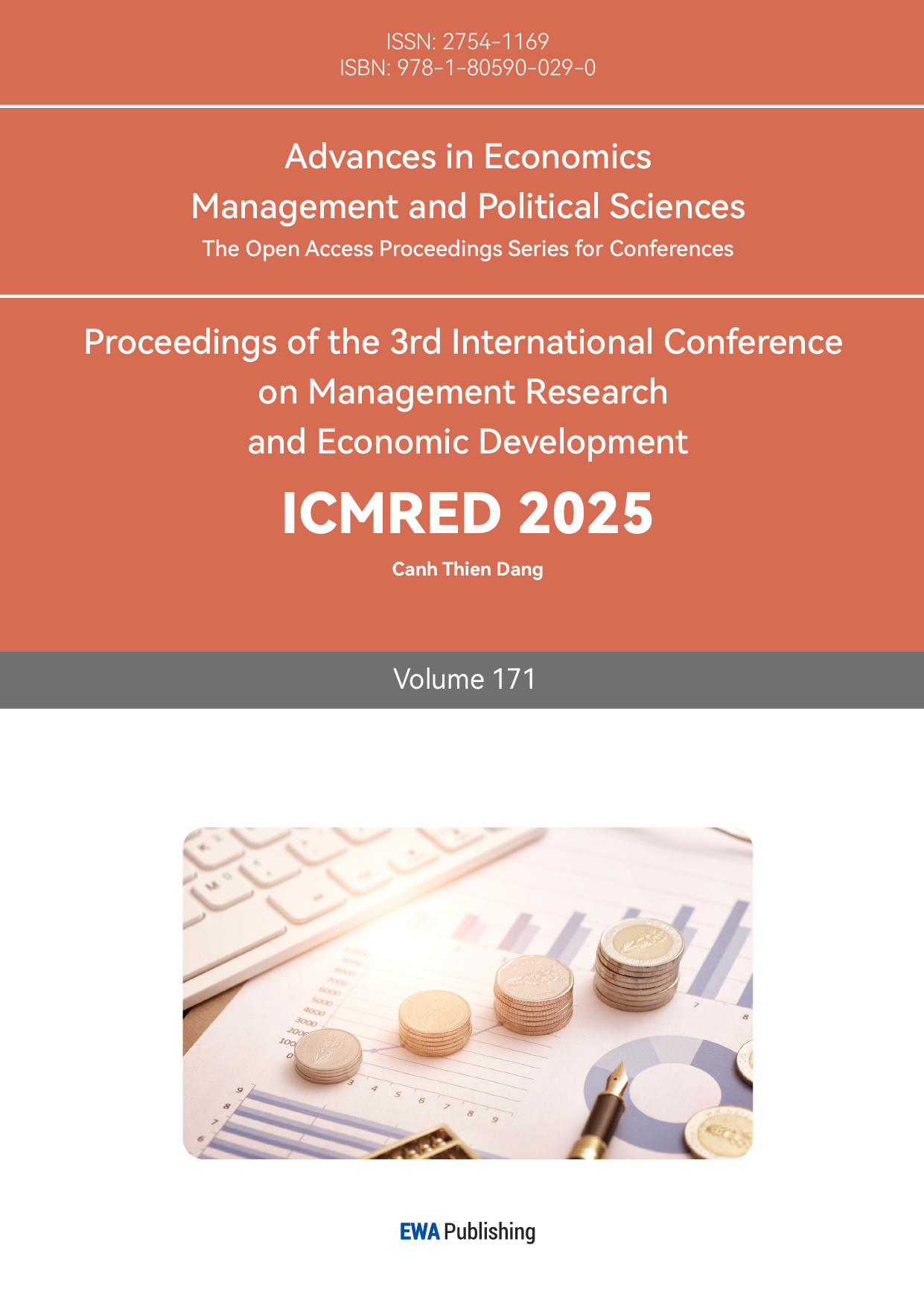1. Introduction
The rapid rise of social media has revolutionized the beauty industry as influencers play a pivotal role in shaping consumer trends. Social media platforms such as TikTok incorporate "hashtags" from challenges to viral campaigns as a strategy to boost marketing initiatives. One major trend was the #EyesLipsFace campaign by e.l.f, one of the best examples of using TikTok to promote brand awareness. However, the gradual dependence on the influencer-driven cosmetic markets poses serious questions about cosmetics, including their ethical behavior, transparency, and the mental health of adolescent customers.
The extensive utilization of social media sites like Instagram, TikTok, and other platforms makes teenagers particularly susceptible to its impact. These algorithms were designed to appeal to people, feeding a vicious cycle of impulsive buying and developing unattainable beauty standards. This situation worsens because influencers may reach millions of views with a single post or video. Although these marketing tactics present business possibilities, they also make it harder for customers to distinguish between sponsored cosmetics ads and real endorsements, making it more challenging to differentiate them [1].
Furthermore, there are serious ethical ramifications to targeting such a vulnerable group. Several societal issues, from deceptive claims to dubious product performance, have arisen due to the lax laws controlling the use of influencers in advertising. Evaluating these marketing strategies thoroughly and determining how they affect young customers as the cosmetics business develops is essential. The following inquiries are the focus of this study: What dangers do teens who purchase cosmetics from influencers face? In what ways do these marketing tactics take advantage of customer behavior? Furthermore, what legal actions might lessen these dangers?
2. MoCRA – Recent Efforts from Authorities to Regulate the Cosmetic Marketplace
As the cosmetic marketplace evolves, more stringent laws ensure accountability and safety. New compliance rules, such as the Modernization of Cosmetics Regulation Act of 2022 (MoCRA), are implemented to address oversight gaps. This section reviews its main clauses and their effects on beauty brands.
The Modernization of Cosmetics Regulation Act of 2022 (MoCRA) fundamentally changed the cosmetics industry in the United States by enacting safety, labeling, and manufacturing requirements to improve consumer protection and product accountability. MoCRA requires facility registration, product listing, and adherence to Good Manufacturing Practices (GMP) in compliance with international standards like ISO 22716. It builds public trust by guaranteeing that cosmetics displayed are made and kept in a way that is safe and traceable [2]. The Society of Chemical Manufacturers and Affiliates (SOCMA) conveys the act obliges that "Responsible Persons" (manufacturers, packers, or distributors) keep records attesting to the safety of their products, report adverse events to the FDA, and update product labels to include fragrance allergens and reporting information [2].
MoCRA presents unique compliance opportunities and problems for small beauty brands. According to recommendations in the Akerman, brands with yearly sales of more than $1 million are no longer permitted to manufacture domestically. Instead, they must move to professional facilities meeting MoCRA requirements [3]. High-risk items like eye makeup and injectable cosmetics are not exempt from some criteria, such as GMP and annual product listing. However, small firms may have annual sales under $1 million. According to research from a 2022 study, eye cosmetics commonly result in ocular problems, which supports the need for these items to meet higher safety standards [4].
Furthermore, the act forbids haphazard product launches that do not follow legal requirements on social media. FDA measures like product recalls or fines may result from noncompliance. Small firms should collaborate with MoCRA-compliant beauty labs, which highlight contract manufacturing and private labeling as feasible options. These collaborations make compliance more manageable and allow for scaling production and access to knowledge of safety testing and product composition [5].
Therefore, MoCRA represents a larger drive for responsibility in the cosmetics sector. It requires companies to prioritize consumer safety and legal compliance as they develop and expand.
3. Gen-Z’s Preference and Popular Marketing Tactics on Social Media
However, we believe that more measures are necessary to address the potential issues in this sector, considering the rapid demographic shift and changes in shopping behavior. The term "digital natives" is often used to describe Gen Z, those born between 1997 and 2012, due to their extensive use of social media and technology. Platforms like YouTube, Instagram, and TikTok are integral to their daily lives and purchasing habits, with them spending considerable time on these sites. As digital natives, this demographic has become accustomed to demanding more engaging, personalized, and interactive brand experiences that emphasize uniqueness and community.[6]
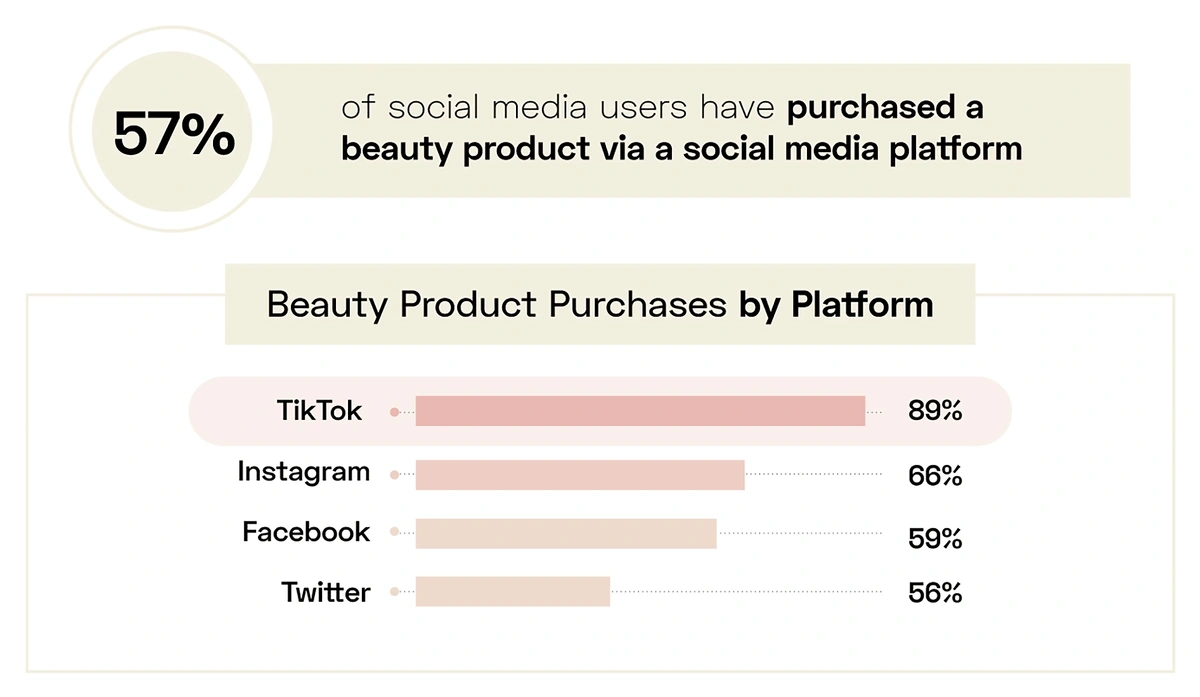
Figure 1: TikTok is the most popular platform for social commerce for beauty products. [7]
Gen Z consumers display unique buying habits motivated by their need for social consciousness, individuality, and authenticity. Gen Z customers are prepared to spend extra for businesses linked to sustainability, diversity, and social responsibility when purchasing cosmetics and looking for items that complement their looks [1]. This preference reflects their broader demand for transparent and genuine interactions with the brands they engage with. The McKinsey report verifies this through findings showing that Gen Z is more inclined to purchase products from brands they perceive as aligned with their identity and values [6]. The following are some successful marketing tactics on TikTok that significantly raised the brand’s publicity and revenue.
3.1. Case #1: E.l.f Viral Challenges
In recent years, viral challenges have emerged as one of the most popular and successful marketing tactics on TikTok aimed at Gen Z. Users are encouraged to provide material for these challenges by following a prompt or topic. e.l.f. 's #eyeslipsface challenge was a significant TikTok milestone. In this challenge, users were urged to demonstrate their makeup techniques using a particular song and dance that came to represent the company.
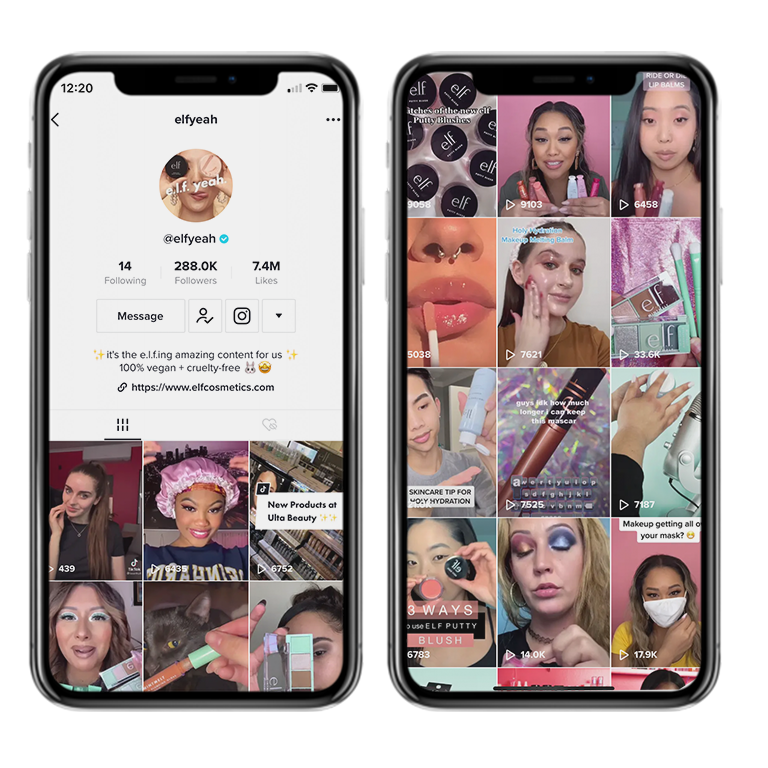 Figure 2: #eyeslipsface viral trend on TikTok. [8]
Figure 2: #eyeslipsface viral trend on TikTok. [8]
E.l.f has successfully appealed to 3 million user-generated videos, boasting more than 4 billion views with the #eyeslipsface hashtag, which currently has over 9.4 billion views [9]. Undoubtedly, this challenge quickly garnered widespread engagement, enabling e.l.f. Cosmetics to leverage the trend and significantly enhance brand visibility among Gen Z consumers. Through these challenges, Gen Z users foster a sense of community and participation, appealing directly to their values of authenticity and self-expression.
3.2. Case #2: Influencer Collaboration - Addison Rae
With over 88 million followers, TikTok influencer Addison Rae co-founded Item Beauty, a skincare and makeup brand. Addison's collaboration with the brand promotes clean, cruelty-free products aimed at Gen Z, making her brand rather popular due to its marketing strategy [10].
The brand experienced rapid growth, with significant sales coming directly from social media promotions. Furthermore, Item Beauty was launched as a partner brand with IPSY, an established beauty subscription service, further boosting visibility [11]. Through authenticity and relatability, Rae successfully helped the brand gain credibility among Gen Z through influencer collaboration. Rae's involvement made the brand and the collaboration feel genuine while aligning with clean beauty and sustainability, values Gen Z consumers tend to prioritize [10].
3.3. User-Generated Content (UGC)
Another significant marketing is where brands encourage consumers to share their personal experiences with their products, a tactic called user-generated content (UGC). Brands leveraging UGC can increase consumer trust and engagement, as more people are likely to trust peer recommendations over traditional advertisements [1]. Through this, brands increase their visibility and carry a sense of community and engagement among online users. Especially with a group of people who value voice and self-expression, TikTok allows consumers to create authentic, original content featuring a brand, which can then be amplified by the brand itself [12].
Ultimately, UGC creates an organic connection between the consumer and the brand by incorporating social proof from real people who enjoy the product. This resonates with Gen Z's desire for genuineness [12].
3.4. Interactive Experiences
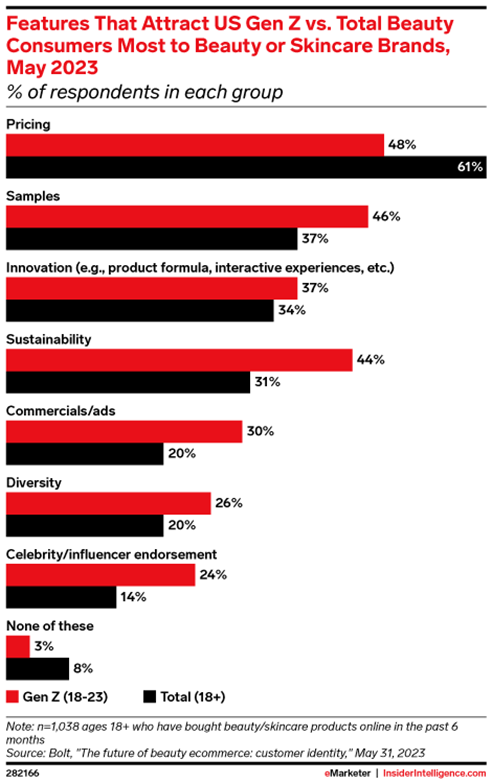
Figure 3: Gen Z are most attracted to cosmetic brands’ pricing, samples, and sustainability. [13]
In conclusion, media platforms have successfully drawn in Gen Z and their ways of purchasing cosmetics through interactive brand experiences. Interactive capabilities and live-streaming built-in social media allow corporations like Sephora to use them as a platform and make real-time customer relationships. Through these exchanges, customers may connect with the brand directly, ask questions, and offer comments, making the experience more intimate and engaging [14].
Gen Z loves quick brand feedback and thrives on in-the-moment connections. Therefore, they are more inclined to connect with businesses that provide real-time involvement, making interactive advertising and live-streaming powerful tools for stimulating brand loyalty [1]. Brand loyalty and connection may be further strengthened by offering these interactive options, which allow companies to produce more dynamic and captivating experiences that transcend passive consumption [14].
4. Potential risks involved in these practices:
Along with the rise of social media exposure, the safety and well-being of teens using cosmetic treatments and products are becoming more of a concern as the beauty industry expands to younger groups. Unregulated cosmetic products, unskilled practitioners, and deceptive marketing tactics expose teenagers to many dangers. Teenagers are especially vulnerable to these risks because they lack awareness about product safety, social media, and cosmetic trends.
Due to the wide accessibility of various cosmetic products, teens often experiment with different skincare and beauty items, frequently overlooking the potential negative effects of these products. Many cosmetics contain chemicals that can irritate the skin, trigger allergic reactions, or lead to more serious health issues. Ingredients found in bath soaps, antiperspirants, eye makeup, moisturizers, and shampoos can cause common reactions, such as redness, itching, breakouts, and inflammation[15]. Teenagers are particularly vulnerable to these effects because of the hormonal changes that occur during puberty, which make their skin more sensitive to harsh, unfamiliar substances in personal care products. This raises the chances of irritation, breakouts, and long-term skin issues.
Similarly, several chemicals in cosmetics, such as phthalates and parabens, disrupt the endocrine system, affecting teenagers' reproductive health and hormone balance. These substances are commonly found in products like teen fragrances, which can result in hormone irregularities, fertility issues, and an increased risk of cardiovascular disease [16]. Despite the growing awareness of these issues, many teenagers continue to use these products without fully understanding their ingredients or potential consequences. Teens are vulnerable to long-term physical and hormonal damage due to their lack of knowledge, targeted marketing, and peer pressure, which often lead them to prioritize trends over their health.
Teenagers exposed to certain chemicals in cosmetics for an extended period are at risk of health problems. Research is progressively connecting these synthetic substances to allergic responses, hormonal imbalances, and chronic diseases. Teenagers, whose developing bodies are more susceptible to hazardous exposure, are disproportionately affected by chemicals like phthalates and parabens, which are frequently concealed in commonplace goods like lotions, shampoos, and cosmetics. Because of their affordability and capacity to prolong product shelf life, many cosmetic businesses still employ these chemicals despite these risks.
The problem is exacerbated by the opaqueness of product labels, which make it practically hard for youngsters to recognize and steer clear of dangerous substances. The Guardian claims that because of insufficient restrictions, people are usually ignorant of the dozens of "high hazard" poisons that are frequently included in cosmetic products, including carcinogens and endocrine disruptors [17]. Teens continue to be exposed to potentially toxic chemicals daily in the absence of stricter regulatory control and required disclosure of harmful compounds. More stringent regulations and consumer activism are desperately needed to solve this, drive the cosmetics sector toward safer, non-toxic substitutes, and guarantee better public health protection.
5. Mitigation Strategies
To minimize the risks connected to cosmetic operations and products, the following proactive measures may be taken by consumers, teenagers, parents, and companies to mitigate the harm:
Select Skilled Professionals: Teenagers must realize that cosmetic treatments should only be carried out by qualified specialists to reduce the danger of problems and long-term harm. Adolescents should avoid unlicensed facilities that promote inexpensive therapies without the necessary qualifications.
• Stay Informed: Teens and parents should take action by reading product labels before making purchases and being aware of common dangerous chemicals. Furthermore, corporations could ensure safety and regulatory compliance in the cosmetics sector by staying current on new laws and scientific studies through news reports or announcements.
• Conduct Patch Tests: Teens should perform a patch test to screen for allergic responses before using new cosmetic items. Exposure to unknown allergens in cosmetics can result in a number of unidentified skin disorders.
• Maintain Proper Hygiene: Teenagers are less likely to get infections when they practice good hygiene during cosmetic operations. This includes sterilizing instruments and using hygienic application techniques. This is especially crucial for procedures like skin resurfacing or injections.
• Impose Stricter Regulations: Tighter laws, such as more transparent labeling, prohibitions on dangerous ingredients, and limitations on teen-targeted advertising, can help prevent dangerous goods and practices from reaching susceptible adolescents.
By being more informed and aware of these possible hazards, teens may make decisions and take the safeguards that prioritize their long-term health and well-being over beauty fads.
6. Why MoCRA Regulation Works and Why It’s Not Enough
The Modernization of Cosmetics Regulation Act of 2022 (MoCRA) is evidence of a significant step toward guaranteeing teen safety, consumer safety, and business responsibility in the cosmetics sector. Unquestionably, MoCRA has improved transparency and held businesses accountable for the chemicals and compounds they use in cosmetic items by requiring product registration and safety data. Producers must adhere to GMP's guarantees that cosmetics fulfill safety requirements before being distributed to customers. Imposing MoCRA empowers teenagers to take control of their personal care routines, creating a sense of responsibility and awareness about the products they use daily.
However, MoCRA does not entirely address all worries about the safety of cosmetics for minors, even though it provides a much-needed regulatory framework in the cosmetic industry. The absence of a total prohibition on dangerous substances like parabens and phthalates, which have been connected to allergic responses, hormonal imbalances, and other long-term health hazards, is one significant drawback [17]. Instead of outright banning dangerous components, MoCRA demands the reporting of adverse reactions, in contrast to EU rules that have outlawed thousands of potentially dangerous compounds in cosmetics [3]. This discrepancy draws attention to a severe weakness in consumer protection, as reporting adverse reactions alone might not be enough to stop harm before it happens. The EU's precautionary approach strongly emphasizes prevention, raises the bar for safety, and emphasizes the necessity of stronger laws in other areas. Therefore, this flaw in MoCRA highlights how crucial it is to promote stricter regulatory frameworks that put consumer health ahead of business convenience, particularly in the North American Sector.
Another urgent issue to combat is the loophole in social media marketing, which allows influencers to continue promoting items without fully disclosing possible hazards. While MoCRA enhances the control of conventional marketing, it does not fully regulate cosmetics used in TikTok beauty trends and viral product launches, frequently leading to teens making hasty purchases. Many companies continue to use ambiguous phrases like "natural" and "clean" without precise meanings, deceiving young people into believing a product is safer than it is. For example, “natural” or “clean” formulations have become more popular on TikTok, yet the scientific evidence supporting some of these claims is still ambiguous [18]. Many of these claims lack solid, unambiguous scientific support, which raises questions regarding disinformation and the possibility of consumer deception. This emphasizes teenagers' need to assess the promises made by TikTok products and base their selections on reliable information rather than fads. Furthermore, several MoCRA regulations do not apply to small beauty firms with yearly sales under $1 million, allowing potentially hazardous items to be sold without regulatory oversight [3]. This loophole creates opportunities for firms to evade thorough testing, especially on social media sites like Instagram and TikTok, where quick product debuts are typical.
Although MoCRA lays the groundwork for increased cosmetic safety, its shortcomings still allow for deceptive advertising, unstated dangers, and contact with dangerous chemicals. These laws must be strengthened to safeguard young customers and guarantee that beauty businesses prioritize the public's health over profit-driven trends.
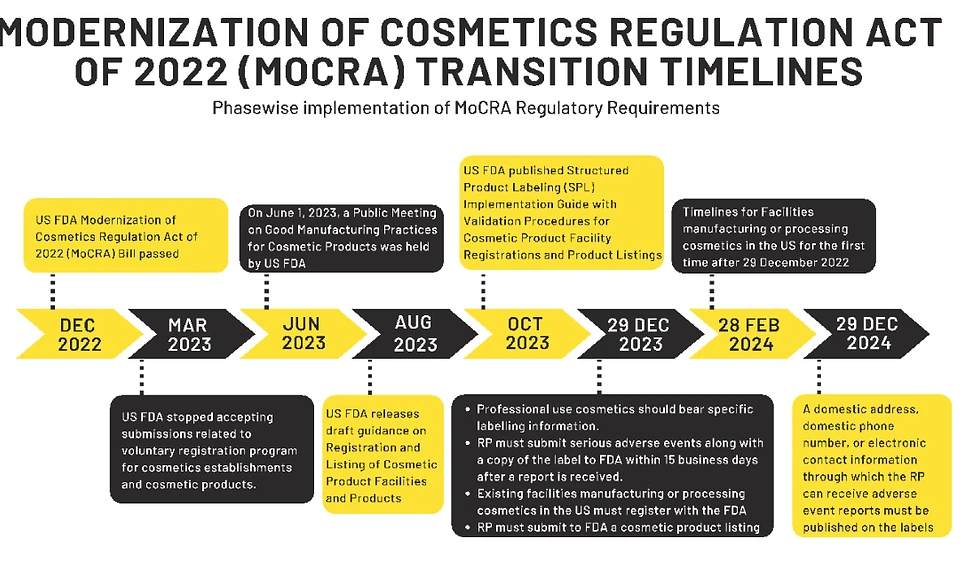
Figure 4: Timeline of MoCRA from 2022-2024. [19]
7. Recommendations: How We Can Do More
While strides have been made in the Modernization of Cosmetics Regulation Act (MoCRA), more urgent action is required to shield young consumers from dangerous goods and marketing tactics. The following suggestions will build upon MoCRA's accomplishments.
7.1. Strengthen Social Media Regulation
One of the most critical problems to solve is the absence of regulations on influencer marketing, especially on sites like TikTok. Influencers usually advertise goods without fully revealing the hazards, encouraging teens to make rash purchases to keep up with fads.
Implementing precise rules and limitations for influencers can counteract this issue and reveal any sponsored collaborations or product hazards. Enforcing regulatory control of social media influencers and companies is also crucial to ensure that the influencers give accurate and transparent information about the goods they endorse. One example is ensuring that the claims made by influencers on cosmetic products have scientific support and standardized terminology.
7.2. Increase Consumer Education and Awareness
Numerous young people are unaware of the dangers of cosmetics since they do not have enough transparent information about them. Teenagers who have the necessary information would be better able to stay away from dangerous ingredients and deceptive advertising. Teenagers may fulfill this duty independently by starting public awareness campaigns on cosmetic safety through school assemblies, social media, and youth-focused venues. Teens would be inspired to think critically and recognize influencers' subtle marketing strategies if they could experience such concerns directly. Because of this, many teens can better defend themselves and even refuse trends since they are aware of the harm they might cause.
7.3. Strengthen Product Safety and Ingredient Transparency
Even though MoCRA has made significant improvements in the cosmetic industry, more can be done to control product safety, especially regarding dangerous substances and unsubstantiated claims. Big or small, brands should not be permitted to make unsupported claims about their health or appearance, particularly regarding items aimed at teenagers. Stricter prohibitions may involve more thorough testing of components, especially those frequently found in goods marketed to teenagers. Enforcing labeling regulations for phrases such as "clean," "natural," and "organic" is also required to ensure that these claims are backed by scientific research and fulfill strict industry standards. This would provide customers with greater transparency by preventing false claims about the safety of items.
7.4. Foster Industry Collaboration for Better Compliance
Smaller cosmetic firms may find it prohibitively expensive to comply with MoCRA laws, which might result in varied safety standards. These laws urge smaller firms to collaborate with contract manufacturers that adhere to MoCRA and other safety rules to enable smaller businesses to comply while preserving product safety. These collaborations can support upholding safety regulations and guarantee that smaller businesses can prosper without endangering customers' safety. This might be accomplished by providing rewards, such as certificates or "clean beauty" labels approved by impartial organizations, to companies who voluntarily adhere to the strictest guidelines for cosmetic safety. Subsequently, companies can be motivated to put the health and safety of their customers first, even in a cutthroat market.
7.5. Implement Stricter Enforcement of Advertising Standards
Lastly, even with the most significant regulatory efforts, marketing rules are still not enforced, and advertisements are frequently passed off as natural material on social networking sites. The FDA and other regulatory agencies should collaborate closely with social media companies to improve oversight of influencer marketing to enforce stronger legislation. This would guarantee that all sponsored material is immediately recognizable and that any items pushed adhere to safety regulations. Increasing the severity of sanctions for businesses or influencers that disobey these rules, such as heavy fines or forced product recalls for improper marketing techniques, would encourage openness and provide a more powerful disincentive for deceptive advertising.
8. Conclusion
Unquestionably, the beauty business has transformed due to social media's emergence, influencing marketing tactics and customer behavior. Brands now have unmatched access to younger audiences thanks to social media platforms, which use viral trends and influencer marketing to increase sales. However, significant dangers have emerged from this progression, such as false product claims, a lack of transparency, and possible health issues brought on by uncontrolled chemicals. Teens are especially susceptible to these strategies, which puts them at risk of exposure to dangerous substances and rash purchases.
The Modernization of Cosmetics Regulation Act (MoCRA), which increases ingredient transparency and product safety control, is a positive move but lacks in some important areas. Loopholes in consumer protection remain, as seen by exemptions for smaller beauty firms, the persistence of dangerous substances in cosmetics, and flaws in laws governing influencer marketing. In an industry that puts trends ahead of long-term health, young consumers will continue to be in danger until there are more enforcement measures, updated regulations, and more transparent labeling guidelines.
A multifaceted, cohesive strategy is required to guarantee a secure and accountable beauty business. Stricter laws governing influencer marketing, better consumer education, and uniform labeling claims are all necessary to make the cosmetics sector more open about its operations. By advocating for these advancements, the beauty industry can shift from reactive regulation to a proactive, consumer-first strategy that prioritizes safety, authenticity, and moral corporate practices.
Holding the beauty industry responsible for its goods and advertising tactics is crucial when the internet's impact on consumer culture is at its peak and continues to grow. By making these adjustments and taking these steps, the industry can balance creativity and moral obligation, guaranteeing that beauty continues to be an environment that empowers consumers of all ages rather than exploits them.
References
[1]. M. Kuzminov, “Council post: How influencers can drive consumer purchasing behavior, ” Forbes, https://www.forbes.com/councils/forbesagencycouncil/2024/08/14/how-influencers-can-drive-consumer-purchasing-behavior (accessed Feb. 24, 2025).
[2]. M. Skelley, “Issue summary: Modernization of cosmetics regulation act of 2022, ” Society of Chemical Manufacturers & Affiliates, https://www.socma.org/issue-summary-modernization-of-cosmetics-regulation-act-of-2022 (accessed Feb. 24, 2025).
[3]. L. X. Massie and F. L. Nowels, “New FDA Regulatory Framework for cosmetics: The Modernization of Cosmetics Regulation Act of 2022 (MOCRA), ” Akerman LLP, https://www.akerman.com/en/perspectives/new-fda-regulatory-framework-for-cosmetics-the-modernization-of-cosmetics-regulation-act-of-2022-mocra.html (accessed Feb. 24, 2025).
[4]. “What should I do if I have a reaction to a cosmetic product?, ” U.S. Food and Drug Administration, https://www.fda.gov/cosmetics/resources-consumers-cosmetics/what-should-i-do-if-i-have-reaction-side-effect-cosmetic-product (accessed Feb. 24, 2025).
[5]. L. O. Connor, “MOCRA 101: How to comply with the new FDA laws, ” Genie Supply, https://www.geniesupply.com/blog/mocra-small-beauty-brand (accessed Feb. 24, 2025).
[6]. T. Francis and F. Hoefel, “‘true gen’: Generation Z and its implications for companies, ” McKinsey & Company, https://www.mckinsey.com/industries/consumer-packaged-goods/our-insights/true-gen-generation-z-and-its-implications-for-companies (accessed Feb. 24, 2025).
[7]. J. Howarth, Beauty Product Purchases by Platform. 2025.
[8]. TikTok Page of Elfyeah Depicting 288k Followers with 7.4 Million Likes. Shorty Awards.
[9]. Chatdesk, “#eyeslipsface Challenge, ” Elf Tiktok Campaign and case study, https://www.chatdesk.com/tiktok-campaigns-and-case-studies/elf-eyeslipsface-hashtag-challenge (accessed Feb. 24, 2025).
[10]. M. Robin, “Tiktok Star Addison Rae launched a makeup brand and told US all about it, ” Allure, https://www.allure.com/story/tiktok-star-addison-rae-item-beauty-makeup-line-interview (accessed Feb. 24, 2025).
[11]. M. Aberman, “Addison Rae Launches Item Beauty: New cruelty-free makeup line, ” IPSY, https://www.ipsy.com/blog/addison-rae-item-beauty-launch (accessed Feb. 24, 2025).
[12]. N. Desktop, “Targeting gen Z: Marketing strategies on tiktok, ” Noble Desktop, https://www.nobledesktop.com/learn/social-media-marketing/targeting-gen-z-marketing-strategies-on-tiktok (accessed Feb. 24, 2025).
[13]. M. Yuen, Features That Attract US Gen Z vs. Total Beauty Consumers Most to Beauty or Skincare Brands, May 2023. EMarketer, 2023.
[14]. G. Insights, “Tiktok marketing: Engaging gen Z with vibrant content strategies, ” Gray Group International, https://www.graygroupintl.com/blog/tiktok-marketing (accessed Feb. 24, 2025).
[15]. WebMD Editorial Contributors, “Cosmetics skin allergy triggers, treatments and prevention, ” WebMD, https://www.webmd.com/allergies/cosmetics (accessed Feb. 24, 2025).
[16]. C. Stern, “Hidden ingredient in your perfume can lead to heart problems, obesity, and infertility, ” New York Post, https://nypost.com/2024/12/03/lifestyle/perfume-ingredient-can-lead-to-heart-issues-and-infertility-say-doctors (accessed Feb. 24, 2025).
[17]. T. Perkins, “Dozens of ‘high hazard’ toxins are common in beauty products – report, ” The Guardian, https://www.theguardian.com/us-news/2024/nov/04/beauty-products-toxins-chemicals (accessed Feb. 24, 2025).
[18]. E. V. Bramley, “It’s the pits! would you pay £35 for one of the new, posh deodorants?, ” The Guardian, https://www.theguardian.com/society/2025/jan/04/its-the-pits-would-you-pay-35-for-one-of-the-new-posh-deodorants (accessed Feb. 24, 2025).
[19]. Modernization of Cosmetic Regulations Act of 2022 (MoCRA) Transition Timelines. Artixio, 2023.
Cite this article
Liu,Z. (2025). Beauty in the Digital Age: How Social Media Shapes Gen Z’s Cosmetic Trends, Consumer Behavior, and Its Ethical Concerns. Advances in Economics, Management and Political Sciences,171,68-78.
Data availability
The datasets used and/or analyzed during the current study will be available from the authors upon reasonable request.
Disclaimer/Publisher's Note
The statements, opinions and data contained in all publications are solely those of the individual author(s) and contributor(s) and not of EWA Publishing and/or the editor(s). EWA Publishing and/or the editor(s) disclaim responsibility for any injury to people or property resulting from any ideas, methods, instructions or products referred to in the content.
About volume
Volume title: Proceedings of the 3rd International Conference on Management Research and Economic Development
© 2024 by the author(s). Licensee EWA Publishing, Oxford, UK. This article is an open access article distributed under the terms and
conditions of the Creative Commons Attribution (CC BY) license. Authors who
publish this series agree to the following terms:
1. Authors retain copyright and grant the series right of first publication with the work simultaneously licensed under a Creative Commons
Attribution License that allows others to share the work with an acknowledgment of the work's authorship and initial publication in this
series.
2. Authors are able to enter into separate, additional contractual arrangements for the non-exclusive distribution of the series's published
version of the work (e.g., post it to an institutional repository or publish it in a book), with an acknowledgment of its initial
publication in this series.
3. Authors are permitted and encouraged to post their work online (e.g., in institutional repositories or on their website) prior to and
during the submission process, as it can lead to productive exchanges, as well as earlier and greater citation of published work (See
Open access policy for details).
References
[1]. M. Kuzminov, “Council post: How influencers can drive consumer purchasing behavior, ” Forbes, https://www.forbes.com/councils/forbesagencycouncil/2024/08/14/how-influencers-can-drive-consumer-purchasing-behavior (accessed Feb. 24, 2025).
[2]. M. Skelley, “Issue summary: Modernization of cosmetics regulation act of 2022, ” Society of Chemical Manufacturers & Affiliates, https://www.socma.org/issue-summary-modernization-of-cosmetics-regulation-act-of-2022 (accessed Feb. 24, 2025).
[3]. L. X. Massie and F. L. Nowels, “New FDA Regulatory Framework for cosmetics: The Modernization of Cosmetics Regulation Act of 2022 (MOCRA), ” Akerman LLP, https://www.akerman.com/en/perspectives/new-fda-regulatory-framework-for-cosmetics-the-modernization-of-cosmetics-regulation-act-of-2022-mocra.html (accessed Feb. 24, 2025).
[4]. “What should I do if I have a reaction to a cosmetic product?, ” U.S. Food and Drug Administration, https://www.fda.gov/cosmetics/resources-consumers-cosmetics/what-should-i-do-if-i-have-reaction-side-effect-cosmetic-product (accessed Feb. 24, 2025).
[5]. L. O. Connor, “MOCRA 101: How to comply with the new FDA laws, ” Genie Supply, https://www.geniesupply.com/blog/mocra-small-beauty-brand (accessed Feb. 24, 2025).
[6]. T. Francis and F. Hoefel, “‘true gen’: Generation Z and its implications for companies, ” McKinsey & Company, https://www.mckinsey.com/industries/consumer-packaged-goods/our-insights/true-gen-generation-z-and-its-implications-for-companies (accessed Feb. 24, 2025).
[7]. J. Howarth, Beauty Product Purchases by Platform. 2025.
[8]. TikTok Page of Elfyeah Depicting 288k Followers with 7.4 Million Likes. Shorty Awards.
[9]. Chatdesk, “#eyeslipsface Challenge, ” Elf Tiktok Campaign and case study, https://www.chatdesk.com/tiktok-campaigns-and-case-studies/elf-eyeslipsface-hashtag-challenge (accessed Feb. 24, 2025).
[10]. M. Robin, “Tiktok Star Addison Rae launched a makeup brand and told US all about it, ” Allure, https://www.allure.com/story/tiktok-star-addison-rae-item-beauty-makeup-line-interview (accessed Feb. 24, 2025).
[11]. M. Aberman, “Addison Rae Launches Item Beauty: New cruelty-free makeup line, ” IPSY, https://www.ipsy.com/blog/addison-rae-item-beauty-launch (accessed Feb. 24, 2025).
[12]. N. Desktop, “Targeting gen Z: Marketing strategies on tiktok, ” Noble Desktop, https://www.nobledesktop.com/learn/social-media-marketing/targeting-gen-z-marketing-strategies-on-tiktok (accessed Feb. 24, 2025).
[13]. M. Yuen, Features That Attract US Gen Z vs. Total Beauty Consumers Most to Beauty or Skincare Brands, May 2023. EMarketer, 2023.
[14]. G. Insights, “Tiktok marketing: Engaging gen Z with vibrant content strategies, ” Gray Group International, https://www.graygroupintl.com/blog/tiktok-marketing (accessed Feb. 24, 2025).
[15]. WebMD Editorial Contributors, “Cosmetics skin allergy triggers, treatments and prevention, ” WebMD, https://www.webmd.com/allergies/cosmetics (accessed Feb. 24, 2025).
[16]. C. Stern, “Hidden ingredient in your perfume can lead to heart problems, obesity, and infertility, ” New York Post, https://nypost.com/2024/12/03/lifestyle/perfume-ingredient-can-lead-to-heart-issues-and-infertility-say-doctors (accessed Feb. 24, 2025).
[17]. T. Perkins, “Dozens of ‘high hazard’ toxins are common in beauty products – report, ” The Guardian, https://www.theguardian.com/us-news/2024/nov/04/beauty-products-toxins-chemicals (accessed Feb. 24, 2025).
[18]. E. V. Bramley, “It’s the pits! would you pay £35 for one of the new, posh deodorants?, ” The Guardian, https://www.theguardian.com/society/2025/jan/04/its-the-pits-would-you-pay-35-for-one-of-the-new-posh-deodorants (accessed Feb. 24, 2025).
[19]. Modernization of Cosmetic Regulations Act of 2022 (MoCRA) Transition Timelines. Artixio, 2023.





